Flood Vulnerability Assessment for Prioritizing and Evaluating Rehabilitation of Ungauged Reservoirs Considering Climate Change
Abstract
1. Introduction
2. Materials and Methods
2.1. Flood Vulnerability Assessment for Ungauged Reservoirs
2.2. Selection of Indicators
2.3. Construction of Indicators
2.4. Assessment of Flood Vulnerability
2.4.1. Standardization
2.4.2. Principal Component Analysis
2.4.3. Flood Vulnerability Assessment
3. Application and Discussion
3.1. Project Reservoirs
3.2. Construction of Indicators
3.2.1. Climate Exposure Indicators
3.2.2. Adaptive Capacity Indicators
3.3. Assessment of Flood Vulnerability
3.3.1. Principal Component Analysis
3.3.2. Flood Vulnerability Indices.
4. Conclusions
Author Contributions
Funding
Conflicts of Interest
References
- CRED (Centre if Research on the Epidemiology of Disasters). CRED Crunch 58—Disaster Year in Review (2019); CRED: Brussels, Belgium, 2020. [Google Scholar]
- Kim, N.W.; Lee, J.-Y.; Park, D.-H.; Kim, T.-W. Evaluation of future flood risk according to RCP scenarios using a regional flood frequency analysis for ungauged watersheds. Water 2019, 11, 992. [Google Scholar] [CrossRef]
- Kundzewicz, Z.W.; Kanae, S.; Seneviratne, S.I.; Handmer, J.; Nicholls, N.; Peduzzi, P.; Mechler, R.; Bouwer, L.M.; Arnell, N.; Mach, K.; et al. Flood risk and climate change: Global and regional perspectives. Hydrol. Sci. J. 2014, 59, 1–28. [Google Scholar] [CrossRef]
- Chernet, H.H.; Alfredsen, K.; Midttomme, G.H. Safety of hydropower dams in a changing climate. J. Hydrol. Eng. 2014, 19, 569–582. [Google Scholar] [CrossRef]
- Choi, J.H.; Yoon, T.H.; Kim, J.S.; Moon, Y.I. Dam rehabilitation assessment using the Delphi-AHP method for adapting to climate change. J. Water Resour. Plan. Manag. 2018, 144, 1–8. [Google Scholar] [CrossRef]
- Lee, G.J.; Park, K.W.; Jung, Y.H.; Jung, I.K.; Jung, K.W.; Jeon, J.H.; Lee, J.M.; Lim, K.J. Analysis of flood control effects of heightening of agricultural Reservoir Dam. J. Korean Soc. Agric. Eng. 2013, 55, 83–93. [Google Scholar] [CrossRef]
- Bolognesi, T. The water vulnerability of metro and megacities: An investigation of structural determinants. Nat. Resour. Forum. 2015, 39, 123–133. [Google Scholar] [CrossRef]
- Kim, W.; Lee, J.; Kim, J.; Kim, S. Assessment of water supply stability for drought-vulnerable boryeong multipurpose dam in South Korea using future dry climate change scenarios. Water 2019, 11, 2403. [Google Scholar] [CrossRef]
- Füssel, H.-M.; Klein, R.J.T. Climate change vulnerability assessments: An evolution of conceptual thinking. Clim. Chang. 2006, 75, 301–329. [Google Scholar] [CrossRef]
- Kablan, M.K.A.; Dongo, K.; Coulibaly, M. Assessment of social vulnerability to flood in urban côte d’Ivoire using the MOVE framework. Water 2017, 9, 292. [Google Scholar] [CrossRef]
- Balica, S.F.; Wright, N.G. Reducing the complexity of the flood vulnerability index. Environ. Hazards 2010, 9, 321–339. [Google Scholar] [CrossRef]
- Park, J.; Kang, M.S.; Song, I. Assessment of flood vulnerability based on CMIP5 climate projections in South Korea. J. Am. Water Resour. Assoc. 2015, 51, 859–876. [Google Scholar] [CrossRef]
- IPCC (Intergovernmental Panel on Climate Change). Climate Change 2007: Impacts, Adaption and Vulnerability; Cambridge University Press: Cambridge, UK, 2007. [Google Scholar]
- Marzi, S.; Mysiak, J.; Santato, S. Comparing adaptive capacity index across scales: The case of Italy. J. Environ. Manag. 2018, 223, 1023–1036. [Google Scholar] [CrossRef] [PubMed]
- Balica, S.F.; Douben, N.; Wright, N.G. Flood vulnerability indices at varying spatial scales. Water Sci. Technol. 2009, 60, 2571–2580. [Google Scholar] [CrossRef]
- ME (Ministry of Environment). Vulnerability Map by Sector to Climate Change; Ministry of Environment: Sejong, Korea, 2012. [Google Scholar]
- Balica, S.F.; Wright, N.G.; Van der Meulen, F. A flood vulnerability index for coastal cities and its use in assessing climate change impacts. Nat. Hazards 2012, 64, 73–105. [Google Scholar] [CrossRef]
- Karmaoui, A.; Balica, S.A. new flood vulnerability index adapted for the pre-Saharan region. Int. J. River Basin Manag. 2019. [Google Scholar] [CrossRef]
- Ryu, J.H.; Kang, M.S.; Jun, S.M.; Park, J.; Lee, K.D. Future inundation characteristics analysis for the cheongmi stream watershed considering non-stationarity of precipitation. J. Korean Soc. Agric. Eng. 2017, 59, 81–96. [Google Scholar]
- NIMR (National Institute of Meteorological Research). Climate Change Scenario Report for IPCC AR5; 11-1360395-000233-01; National Institute of Meteorological Research, Climate Research Division: Seoul, Korea, 2011. [Google Scholar]
- Nasiri, H.; Yusof, M.J.M.; Ali, T.A.M.; Hussein, M.K.B. District flood vulnerability index: Urban decision-making tool. Int. J. Environ. Sci. Technol. 2019, 16, 2249–2258. [Google Scholar] [CrossRef]
- Brooks, N.; Neil, A.W.; Mick, K.P. The Determinants of vulnerability and adaptive capacity at the national level and the implications for adaptation. Glob. Environ. Chang. 2005, 15, 151–163. [Google Scholar] [CrossRef]
- Fraser, E.D.G.; Simelton, E.; Termansen, M.; Gosling, S.N.; South, A. “Vulnerability hotspots”: Integrating socio-economic and hydrological models to identify where cereal production may decline in the future due to climate change induced drought. Agric. For. Meteorol. 2013, 170, 195–205. [Google Scholar] [CrossRef]
- Moss, R.; Babiker, M.; Brinkman, S.; Calvo, E.; Carter, T.; Edmonds, J.; Elgizouli, I.; Emori, S.; Erda, L.; Hibbard, K.; et al. Towards New Scenarios for Analysis of Emissions, Climate Change, Impacts, and Response Strategies; Technical Summary; Intergovernmental Panel on Climate Change: Geneva, Switzerland, 2008. [Google Scholar]
- Balica, S.F.; Popescu, I.; Beevers, L.; Wright, N.G. Parametric and physically based modelling techniques for flood risk vulnerability assessment: A comparison. J. Environ. Model. Softw. 2013, 41, 84–92. [Google Scholar] [CrossRef]
- Koks, E.E.; Jongman, B.; Husby, T.G.; Botzen, W.J.W. Combining hazard, exposure and social vulnerability to provide lessons for flood risk management. Environ. Sci. Policy 2015, 47, 42–52. [Google Scholar] [CrossRef]
- Hurd, B.; Leary, N.; Jones, R.; Smith, J. Relative regional vulnerability water resources to climate change. J. Am. Water Resour. Assoc. 1999, 35, 1399–1409. [Google Scholar] [CrossRef]
- Feteke, A.; Damm, M.; Birkmann, J. Scales as a challenge for vulnerability assessment. Nat. Hazards 2010, 55, 729–747. [Google Scholar] [CrossRef]
- Miranda, F.N.; Ferreira, T.M. A simplified approach for food vulnerability assessment of historic sites. Nat. Hazards 2019, 96, 730–913. [Google Scholar] [CrossRef]
- Chen, J.; Zhong, P.; Wang, M.; Zhu, F.; Wan, X.; Zhang, Z. A risk-based model for real-time flood control operation of a cascade reservoir system under emergency conditions. Water 2018, 10, 167. [Google Scholar] [CrossRef]
- Chen, Y.; Lin, P. The total risk analysis of large dams under flood hazards. Water 2018, 10, 140. [Google Scholar] [CrossRef]
- Jun, S.M.; Kang, M.S.; Song, I.; Hwang, S.H.; Kim, K.; Park, J. Effects of agricultural reservoir rehabilitation on their flood control capacities. J. Korean Soc. Agric. Eng. 2013, 55, 57–68. [Google Scholar] [CrossRef]
- Koh, K.J. A Study on Vulnerability Assessment to Climate Change in Gyeonggi-Do; Gyeonggi Research Institute: Suwon, Korea, 2009. [Google Scholar]
- Reder, A.; Iturbide, M.; Herrera, S.; Rianna, G.; Mercogliano, P.; Gutiérrez, J.M. Assessing variations of extreme indices inducing weather-hazards on critical infrastructures over Europe—The INTACT framework. Clim. Chang. 2018, 148, 123–138. [Google Scholar] [CrossRef]
- Jung, Y.; Choi, M. Survey-based approach for hydrological vulnerability indicators due to climate change: Case study of small-scale rivers. J. Am. Water Resour. Assoc. 2012, 48, 256–265. [Google Scholar] [CrossRef]
- Yujun, Y.; Zhifeng, Y.; Shanghong, Z. Ecological risk assessment of heavy metals in sediment and human health risk assessment of heavy metals in fishes in the middle and lower reaches of the Yangtze River basin. Environ. Pollut. 2011, 159, 2575–2585. [Google Scholar] [CrossRef]
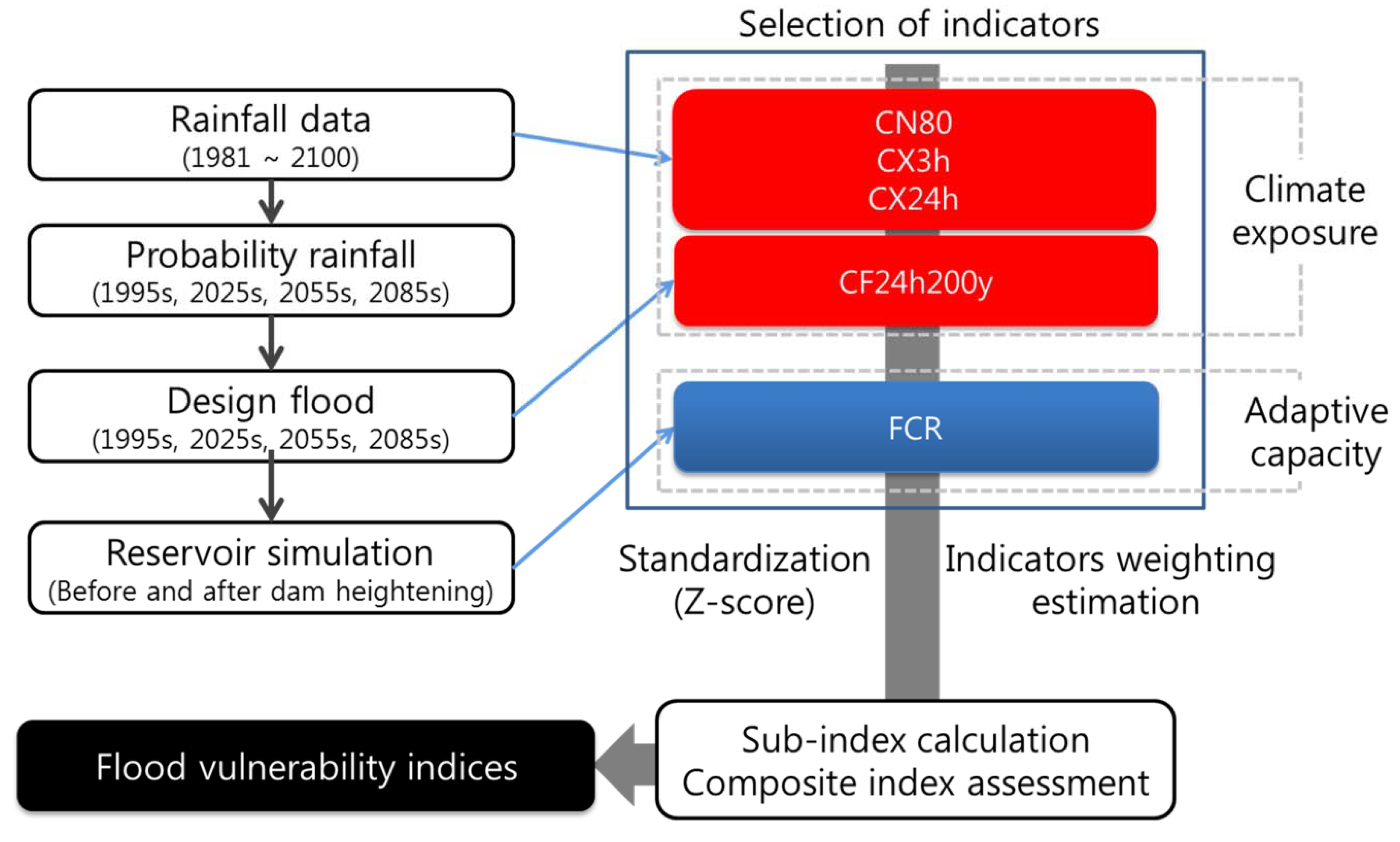

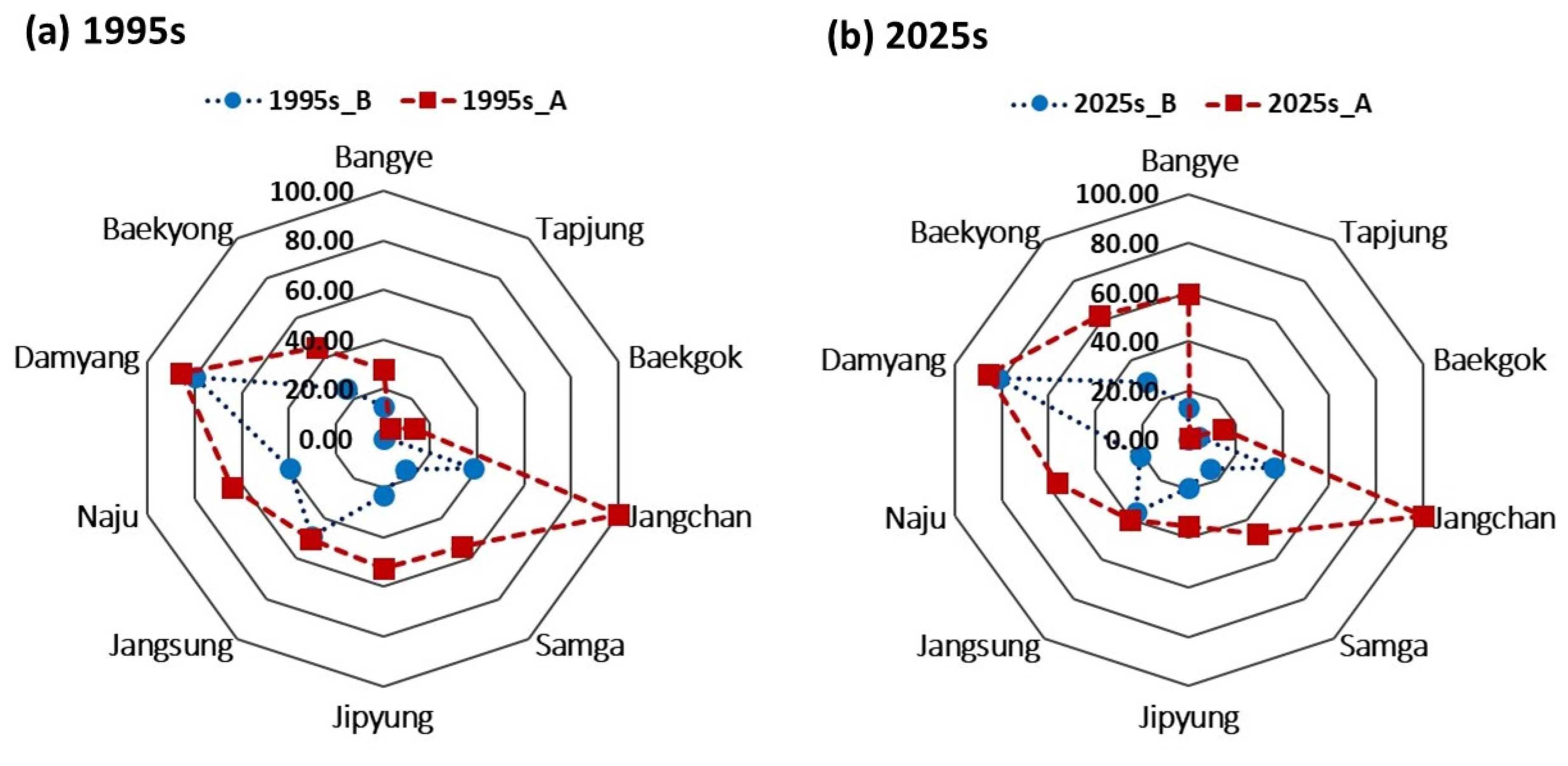
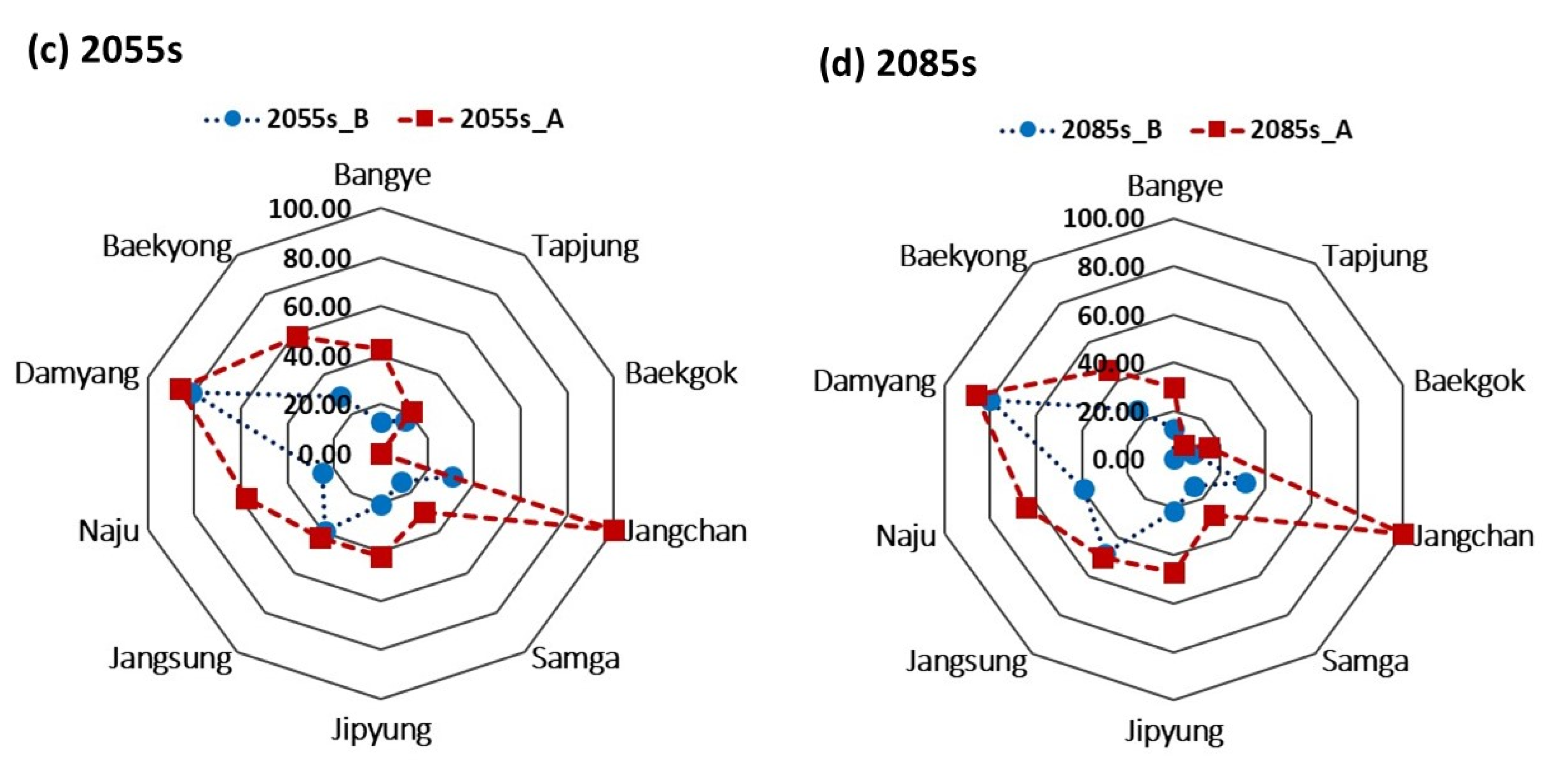
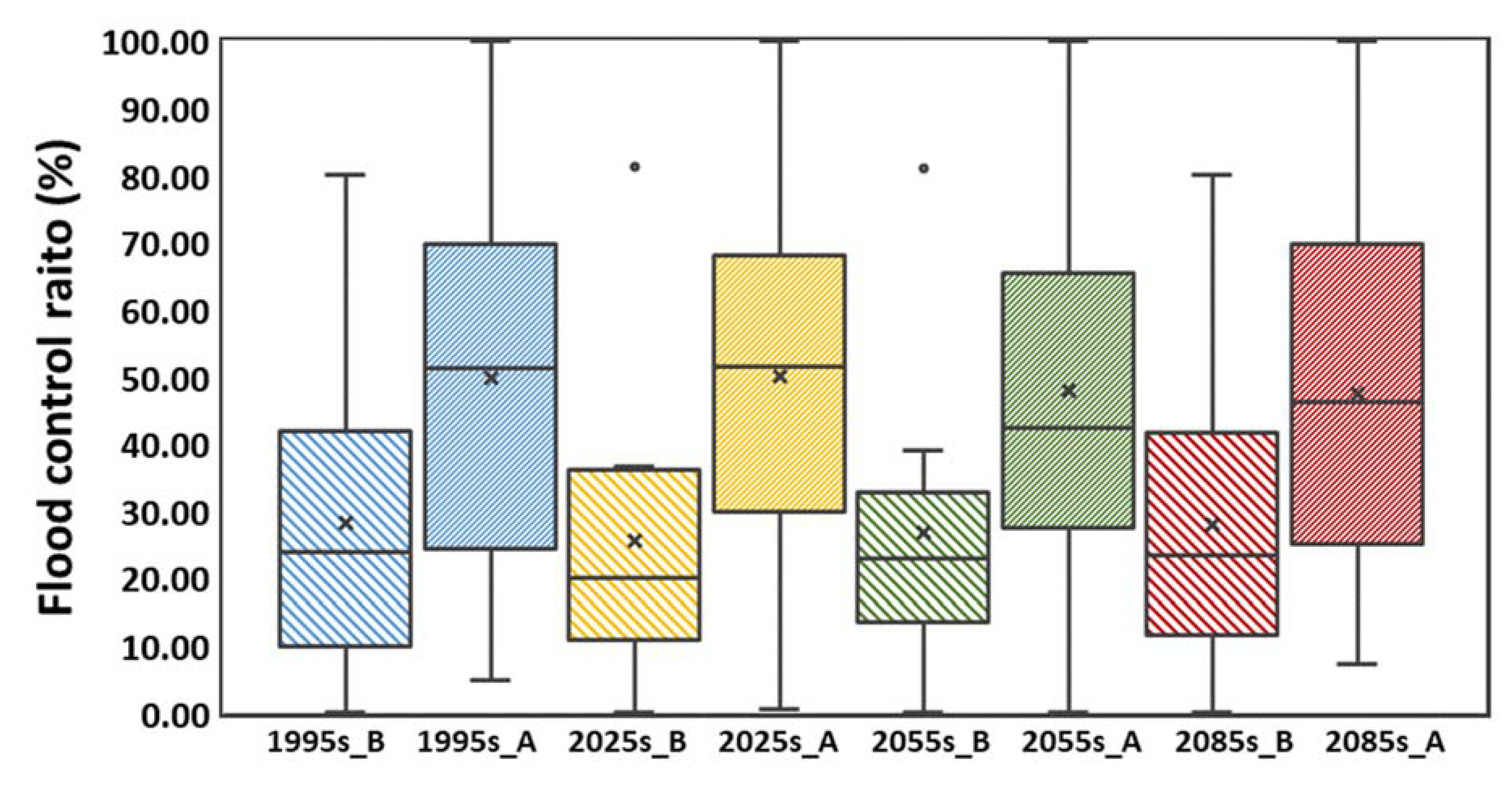
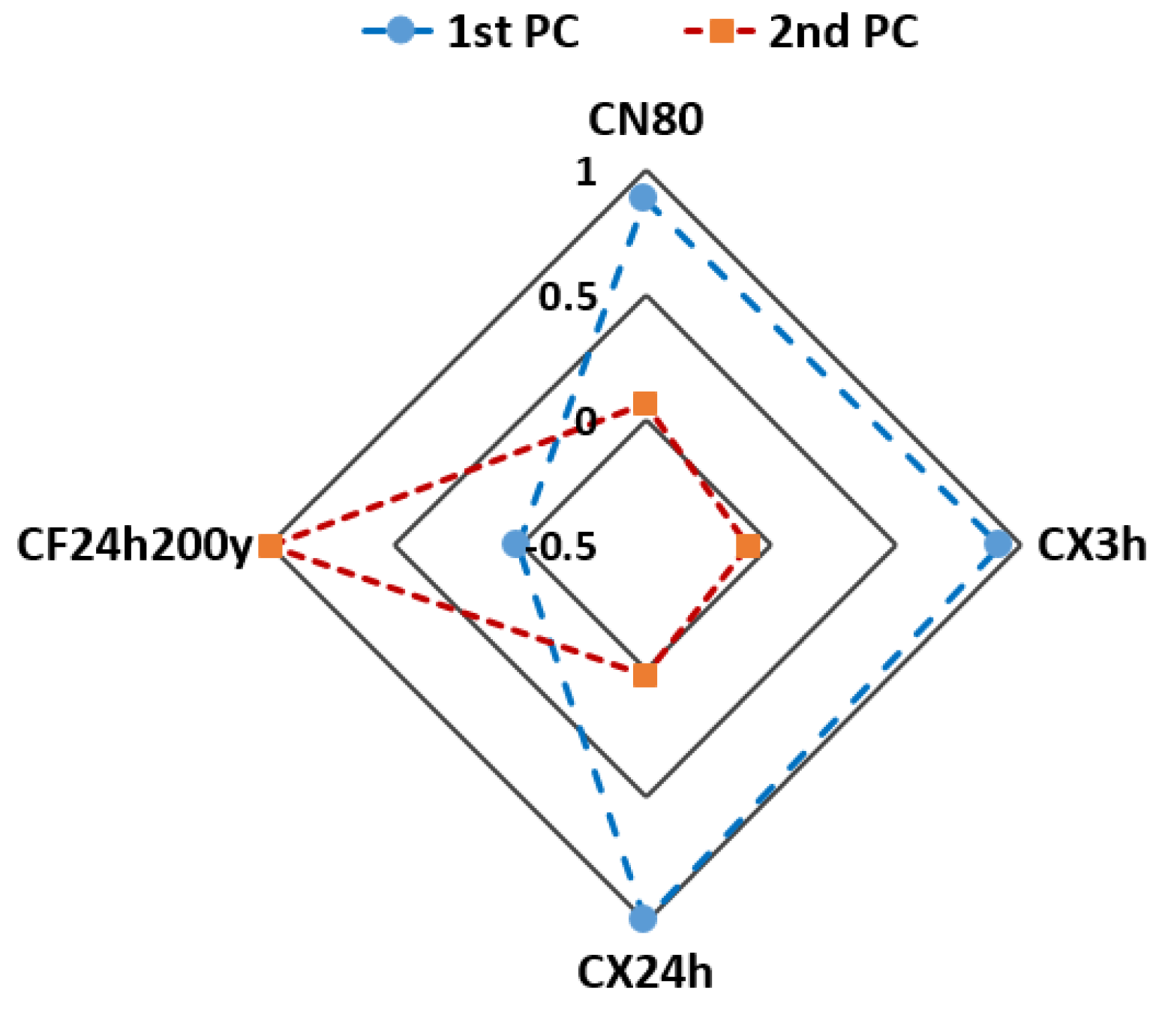
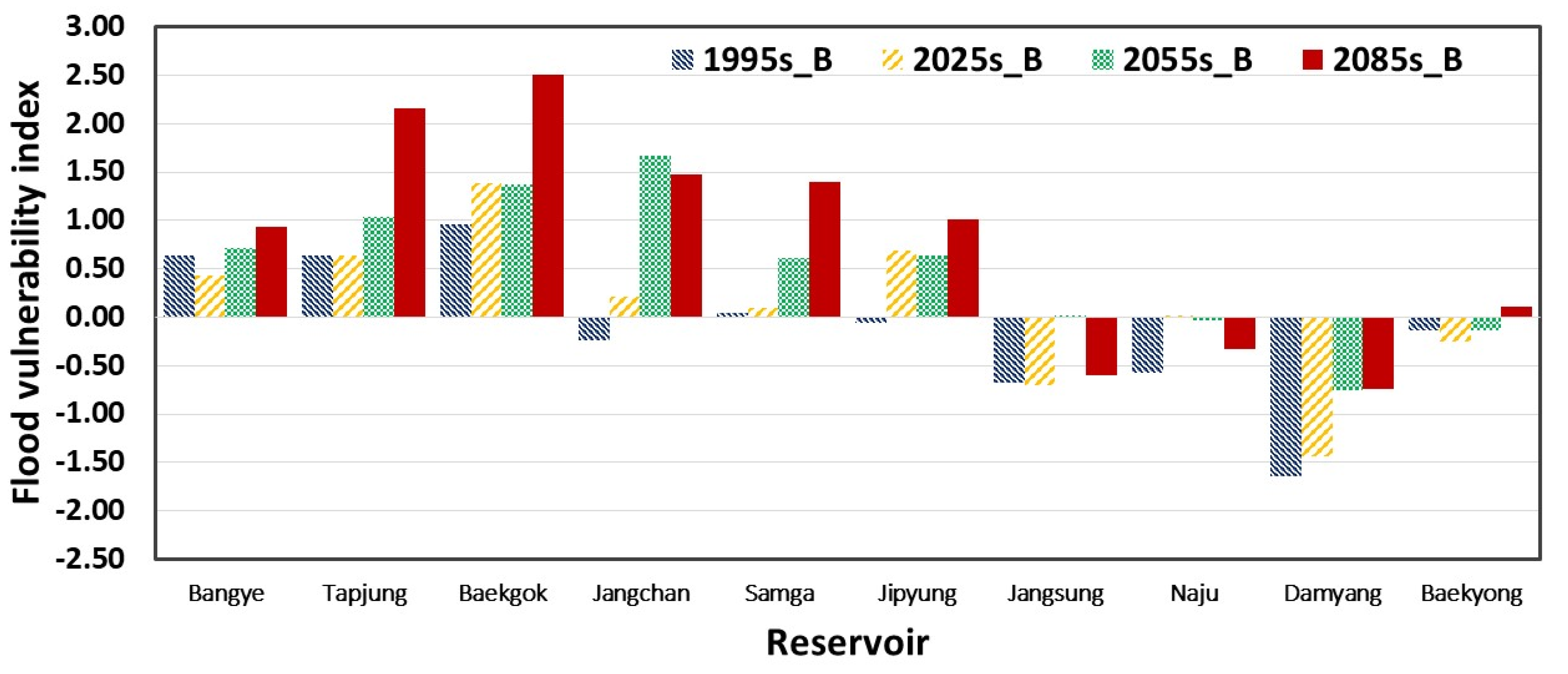

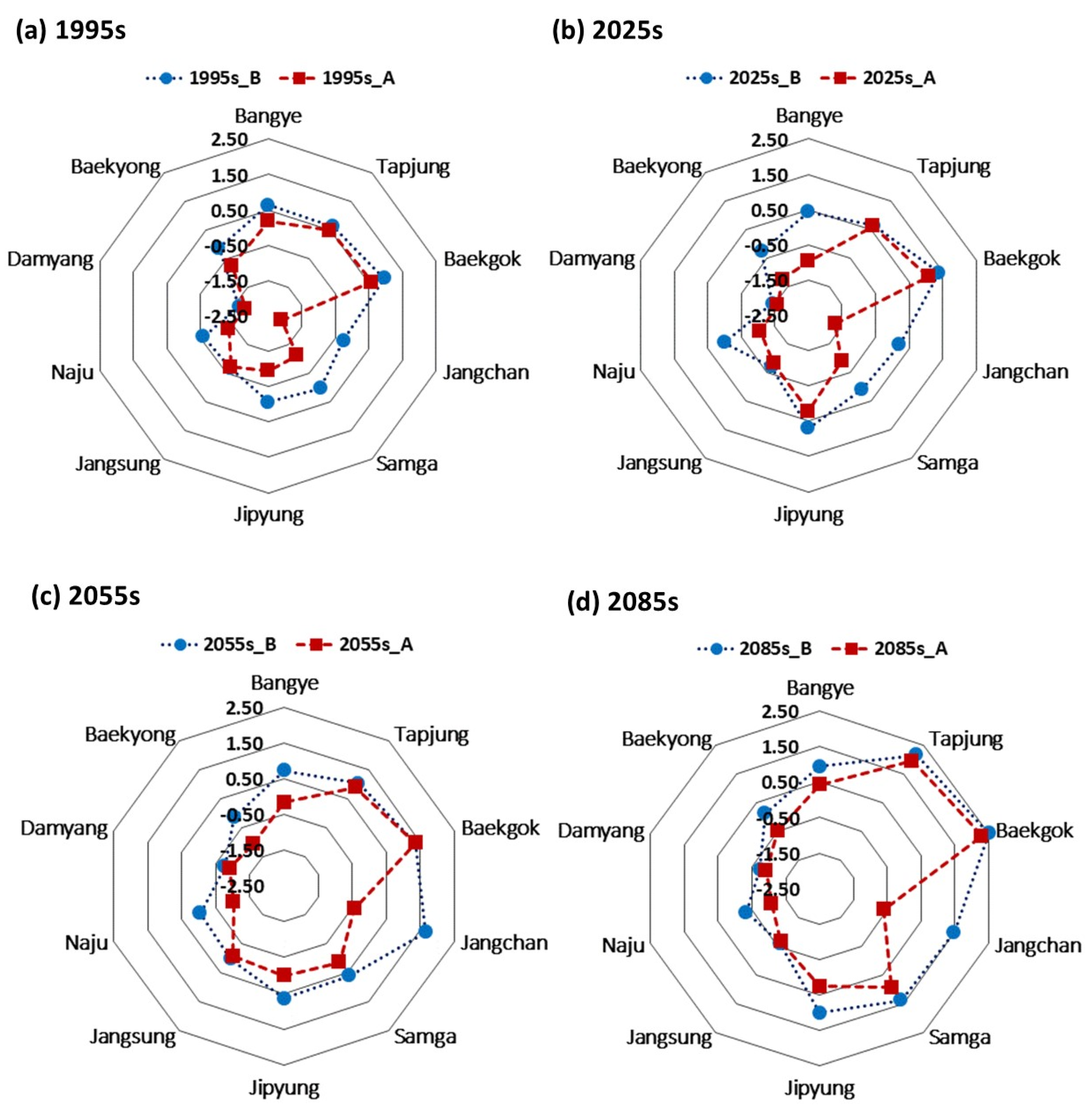
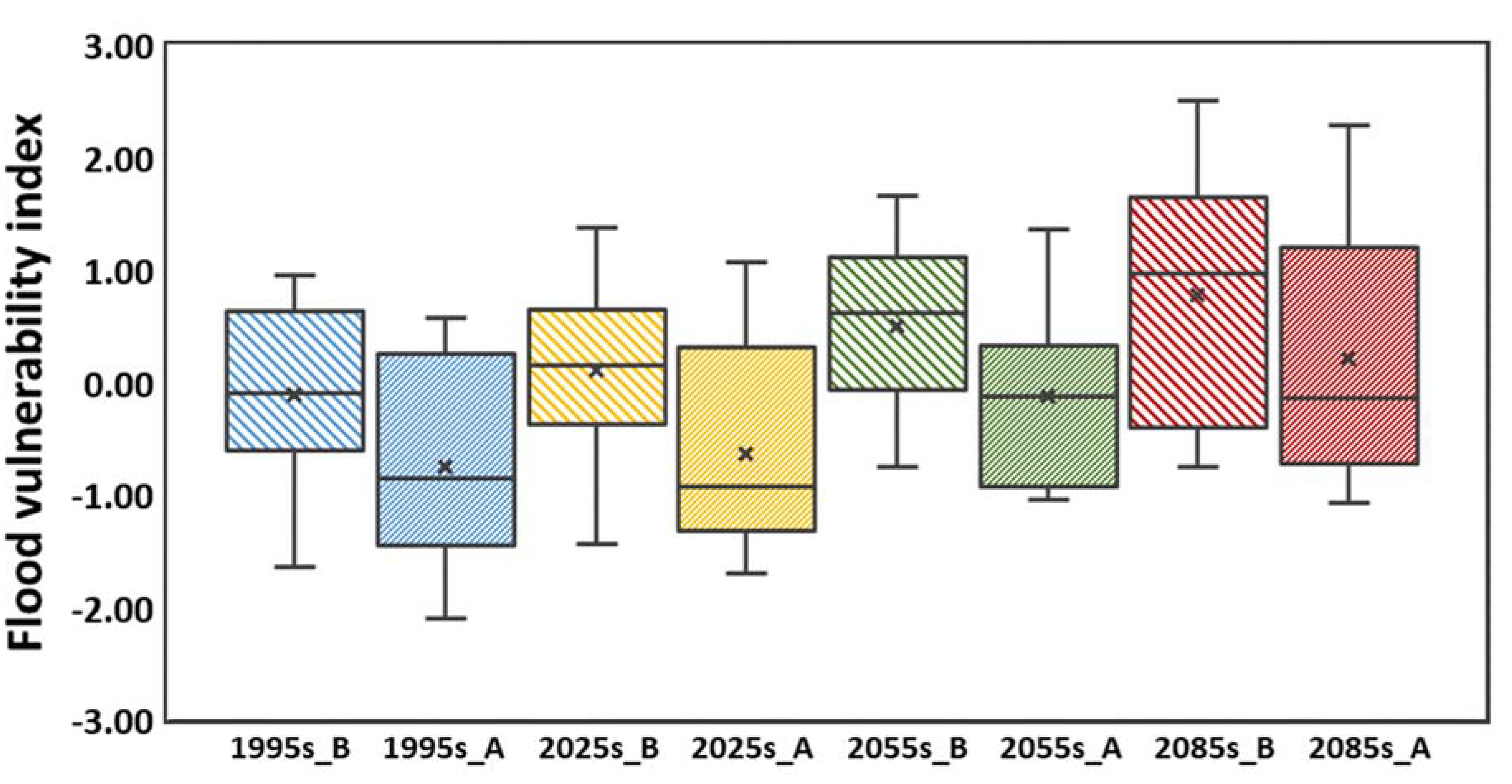
| Indicator | Description | Index | Source |
|---|---|---|---|
| CN80 | Average number of days >80 mm (day) | Climate exposure | [12,33] |
| CX3h | Maximum rainfall for 3-h duration (mm) | [12] | |
| CX24h | Maximum rainfall for 24-h duration (mm) | [12,16] | |
| CF24h200y | Design flood of reservoir watershed divided by watershed area (mm/day) (24-h duration, 200-year frequency) | ||
| FCR | Flood control ratio of reservoir (%) | Adaptive capacity |
| River | Reservoir | Weather Station | Watershed Area (ha) | Total Water Storage Volume (104 m3) | ||
|---|---|---|---|---|---|---|
| Before Dam Heightening | After Dam Heightening | Rate of Increase (%) | ||||
| Han | Bangye | Wonju | 2500 | 174.6 | 283.4 | 62.3 |
| Geum | Tapjung | Geumsan | 21,880 | 3192.7 | 3664.7 | 14.8 |
| Baekgok | Chungju | 8479 | 2175.0 | 2661.8 | 22.4 | |
| Jangchan | Chupungryung | 513 | 425.6 | 539.0 | 26.6 | |
| Nakdong | Samga | Youngju | 2425 | 408.6 | 529.3 | 29.5 |
| Jipyung | Moonkyung | 2556 | 275.8 | 381.2 | 38.2 | |
| Youngsan | Jangsung | Gwangju | 12,280 | 9006.5 | 9989.8 | 10.9 |
| Naju | 8460 | 9132.0 | 10,756.0 | 17.8 | ||
| Damyang | 6560 | 6667.6 | 7506.8 | 12.6 | ||
| Baekyong | 2730 | 248.0 | 380.4 | 53.4 | ||
| Indicator | Unit | 1995s Max. Ave. ± SD Min. | 2025s Max. Ave. ± SD Min. | 2055s Max. Ave. ± SD Min. | 2085s Max. Ave. ± SD Min. | ||||
|---|---|---|---|---|---|---|---|---|---|
| CN80 | day | 2.4 | 2.7 | 3.3 | 3.9 | ||||
| 1.4 | ±0.5 | 1.8 | ±0.6 | 2.1 | ±0.8 | 2.5 | ±0.9 | ||
| 0.8 | 0.9 | 1.1 | 1.2 | ||||||
| CX3h | mm | 57.1 | 68.8 | 98.4 | 102.6 | ||||
| 44.9 | ±6.0 | 57.4 | ±8.5 | 68.9 | ±16.2 | 76.3 | ±16.1 | ||
| 37.0 | 45.6 | 46.1 | 54.3 | ||||||
| CX24h | mm | 142.5 | 184.6 | 218.2 | 271.7 | ||||
| 124.7 | ±14.2 | 153.3 | ±21.8 | 179.8 | ±27.6 | 191.4 | ±47.2 | ||
| 105.2 | 117.7 | 142.1 | 145.6 | ||||||
| CF24h200y | mm/day | 1234.2 | 881.1 | 1500.6 | 1466.8 | ||||
| 981.1 | ±236.1 | 698.7 | ±122.8 | 835.5 | ±256.5 | 917.4 | ±258.8 | ||
| 535.8 | 385.0 | 503.2 | 593.9 | ||||||
| Flood Control Ratio (FCR) (%) | ||||||||||
|---|---|---|---|---|---|---|---|---|---|---|
| Before Dam Heightening | After Dam Heightening | |||||||||
| Period | 1995s | 2025s | 2055s | 2085s | Avg. | 1995s | 2025s | 2055s | 2085s | Avg. |
| Bangye | 13.1 | 13.2 | 12.8 | 12.9 | 13.0 | 28.2 | 59.6 | 42.3 | 30.0 | 40.0 |
| Tapjung | 0.1 | 0.1 | 16.6 | 0.1 | 4.2 | 4.9 | 0.7 | 21.1 | 7.3 | 8.5 |
| Baekgok | 0.7 | 4.4 | 0.2 | 8.2 | 3.4 | 13.2 | 14.7 | 0.2 | 15.3 | 10.9 |
| Jangchan | 38.5 | 36.2 | 30.6 | 31.0 | 34.1 | 100.0 | 100.0 | 100.0 | 100.0 | 100.0 |
| Samga | 15.2 | 14.8 | 14.0 | 14.0 | 14.5 | 53.7 | 47.2 | 29.6 | 28.5 | 39.8 |
| Jipyung | 23.0 | 19.4 | 20.9 | 21.8 | 21.3 | 52.4 | 35.2 | 42.1 | 46.8 | 44.1 |
| Jangsung | 48.8 | 36.6 | 39.2 | 48.5 | 43.3 | 50.3 | 40.4 | 42.5 | 50.2 | 45.9 |
| Naju | 39.6 | 20.9 | 25.0 | 39.5 | 31.3 | 64.4 | 56.1 | 58.0 | 64.4 | 60.7 |
| Damyang | 80.1 | 81.5 | 81.2 | 80.1 | 80.7 | 85.9 | 86.0 | 86.0 | 85.9 | 86.0 |
| Baekyong | 25.0 | 29.4 | 28.6 | 25.1 | 27.0 | 45.5 | 62.2 | 58.7 | 45.6 | 53.0 |
| Ave. | 28.4 | 25.7 | 26.9 | 28.1 | 27.3 | 49.9 | 50.2 | 48.1 | 47.4 | 48.9 |
| Indicator | First Principal Component 64.7% * | Second Principal Component 25.2% * |
|---|---|---|
| CN80 | 0.881 | 0.065 |
| CX3h | 0.909 | −0.096 |
| CX24h | 0.993 | 0.018 |
| CF24h200y | 0.013 | 0.998 |
| Before Dam Heightening | After Dam Heightening | |||||||||
|---|---|---|---|---|---|---|---|---|---|---|
| Period | 1995s | 2025s | 2055s | 2085s | Avg. | 1995s | 2025s | 2055s | 2085s | Avg. |
| Bangye | 0.64 | 0.43 | 0.72 | 0.94 | 0.68 | 0.18 | −0.97 | −0.17 | 0.42 | −0.14 |
| Tapjung | 0.63 | 0.64 | 1.04 | 2.16 | 1.12 | 0.49 | 0.62 | 0.91 | 1.94 | 0.99 |
| Baekgok | 0.96 | 1.38 | 1.37 | 2.51 | 1.56 | 0.58 | 1.07 | 1.37 | 2.30 | 1.33 |
| Jangchan | −0.24 | 0.22 | 1.66 | 1.48 | 0.78 | −2.09 | −1.70 | −0.43 | −0.60 | −1.21 |
| Samga | 0.04 | 0.09 | 0.61 | 1.40 | 0.53 | −1.12 | −0.88 | 0.14 | 0.96 | −0.23 |
| Jipyung | −0.06 | 0.69 | 0.64 | 1.01 | 0.57 | −0.94 | 0.22 | 0.00 | 0.25 | −0.12 |
| Jangsung | −0.67 | −0.71 | 0.02 | −0.60 | −0.49 | −0.72 | −0.82 | −0.08 | −0.65 | −0.57 |
| Naju | −0.58 | 0.01 | −0.03 | −0.32 | −0.23 | −1.33 | −1.05 | −1.02 | −1.07 | −1.12 |
| Damyang | −1.64 | −1.44 | −0.75 | −0.74 | −1.14 | −1.82 | −1.57 | −0.90 | −0.92 | −1.30 |
| Baekyong | −0.13 | −0.25 | −0.14 | 0.11 | −0.10 | −0.75 | −1.24 | −1.05 | −0.51 | −0.89 |
| Ave. | −0.11 | 0.11 | 0.51 | 0.79 | 0.33 | −0.75 | −0.63 | −0.12 | 0.21 | −0.32 |
© 2020 by the authors. Licensee MDPI, Basel, Switzerland. This article is an open access article distributed under the terms and conditions of the Creative Commons Attribution (CC BY) license (http://creativecommons.org/licenses/by/4.0/).
Share and Cite
Jun, S.-M.; Kang, M.-S.; Hwang, S.; Park, J.; Song, J.-H. Flood Vulnerability Assessment for Prioritizing and Evaluating Rehabilitation of Ungauged Reservoirs Considering Climate Change. Water 2020, 12, 1901. https://doi.org/10.3390/w12071901
Jun S-M, Kang M-S, Hwang S, Park J, Song J-H. Flood Vulnerability Assessment for Prioritizing and Evaluating Rehabilitation of Ungauged Reservoirs Considering Climate Change. Water. 2020; 12(7):1901. https://doi.org/10.3390/w12071901
Chicago/Turabian StyleJun, Sang-Min, Moon-Seong Kang, Soonho Hwang, Jihoon Park, and Jung-Hun Song. 2020. "Flood Vulnerability Assessment for Prioritizing and Evaluating Rehabilitation of Ungauged Reservoirs Considering Climate Change" Water 12, no. 7: 1901. https://doi.org/10.3390/w12071901
APA StyleJun, S.-M., Kang, M.-S., Hwang, S., Park, J., & Song, J.-H. (2020). Flood Vulnerability Assessment for Prioritizing and Evaluating Rehabilitation of Ungauged Reservoirs Considering Climate Change. Water, 12(7), 1901. https://doi.org/10.3390/w12071901






